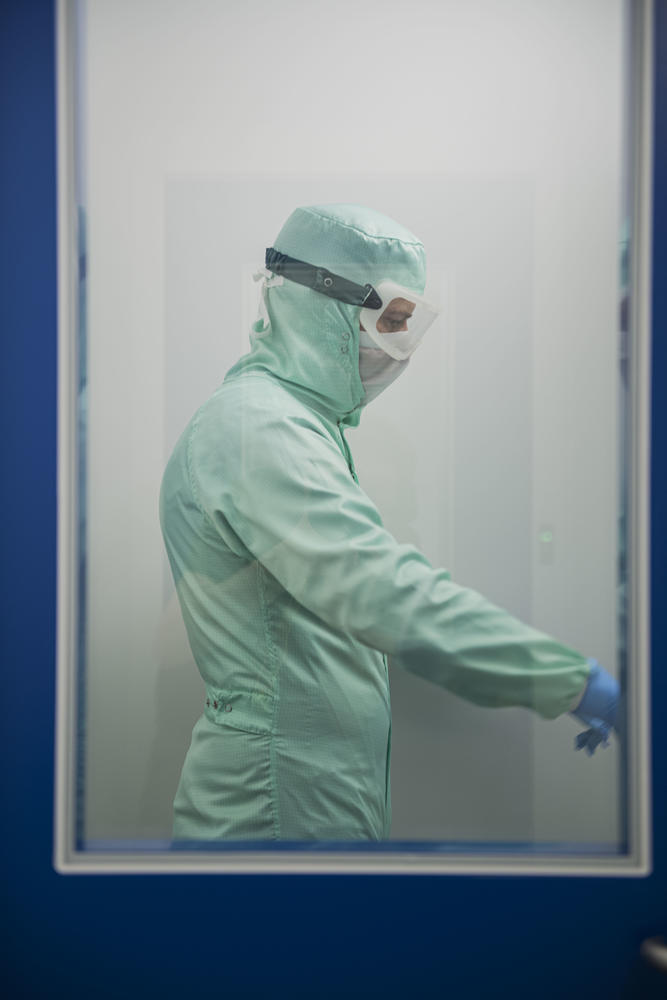Guidelines for cleanroom garment
A cleanroom is an environment with a controlled level of contamination such as dust, microbes, vapors and aerosol particles. A cleanroom class is defined by the number of particles per cubic meter at a specified particle size.
Cleanrooms are used in almost every industry where particles can harm the manufacturing process or contaminate the product. This includes pharmaceuticals, microelectronics, life sciences, biotechnology, food packaging, electronics, automotive and optical industries. Air filtration and airflow management control the concentration of airborne particles inside the room.
Protection of the product made in the cleanroom is essential and the operator inside the cleanroom is the biggest source of contamination risk. Possible cross-contamination can originate from skin flakes, hair, microbes, textile fibers, undergarments, etc. Cleanroom garment act as protection barrier and is designed to minimize or eliminate particle release from the wearer and prevents contamination of cleanroom. The type of cleanroom garments selected should reflect the cleanroom and product specifications.

The operator in the cleanroom is highly trained, but still he is responsible for around 75% of cross contamination issues, leading to unwanted shutdowns and product rejections. Cleanroom garment is the only protection barrier between a product and the highest source of contamination risk inside the controlled environment.
Validating and implementing a quality garment system is absolutely essential to a clean controlled environment and a safe product.
FDA & EU GMP Annex 1
The new annex 1 recently introduced a new set of guidelines for manufacturers of sterile medicines and API's. They are now expected to take a more active approach regarding contamination control strategy by continuously evaluate and effectively control potential risks to quality, supported by scientific data. This includes the selection and validation of a quality garment system.
With decades of know-how and gathering of validation data with its pharmaceutical customers, Alsico Asia Tech offer support in selecting, validating and implementing a garment system complying with GMP Annex 1.
ISO 14644-5 classification

This standard provides the basic requirements for operating and maintaining cleanrooms and associated controlled environments and ranks cleanrooms in ISO classes. The system is rated on the number of airborne particles per m³ and the size of those particles, with 1 being the most hygienic cleanroom environment. The smaller the number, the cleaner the air in the room.
GMP classification

The maximum number of airborne particles permitted per m³ ≥ the tabulated size is used to classify the cleanroom into class A to D.
Cleanroom garment classification

Testing the particle emission rate of a cleanroom gown can assist in the selection of garments for each cleanroom class.
A category 1 garment has a very low particle emission rate (< 2,000 of 0.3μm particles) therefore better suited for grade A/B cleanroom class.
Testing
The most common tests performed on woven fabrics and garments for cleanrooms are:
- Helmke Drum test or ASTM F51
- Tear strength (Elmendorf) (ASTM D2261)
- BodyBox
- Pore size ISO 9237
- Particle filtration efficiency
- Microbial penetration test EN ISO 22612
- Linting test (Gelboflex) / Quick linting tester
- Tensile strength (ASTM D 5034-58035)
- Air permeability (ISO 9237)
- Water vapor permeability BS 7209
- Weight (ASTM E96)
- Electrostatic properties
When using above testing methods to validate cleanroom garment, it is important to also evaluate the performance over the garment's entire life cycle. Results can vary greatly between new clothing and continuous sterilization.
Sterilization
Cleanroom garments and most important, all components of this one particular garment must be compatible with the validated sterilization method:
- EtO
- Steam sterilization
- / 20 min at 121 °C (2050 mbar )
- / 4 min at 134 °C (3050 mbar )
- Beta radiation
- Gamma radiation (25 kGy per cycle)

In-house cleanroom
Our office is equipped with an ISO 9 lab with a build-in BodyBox (ISO 5-6 cleanroom, ISO 7-8 changing room) for product development and testing:
- HSH
- Filtration efficiency
- Color testing
- Washing & drying
- Weight
- Helmke drum
- ...